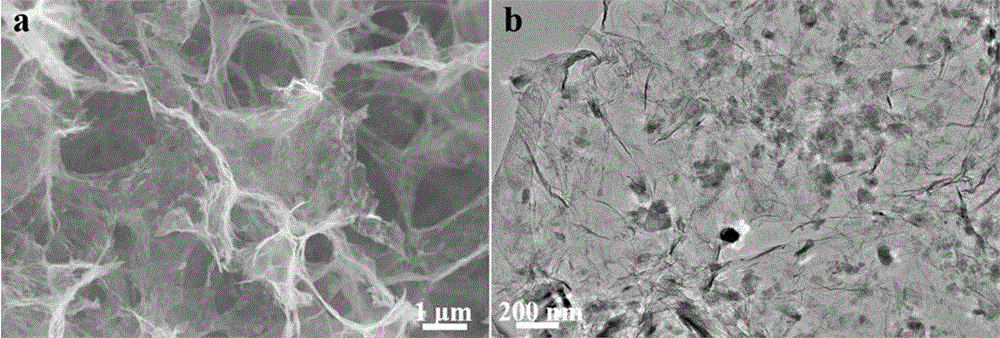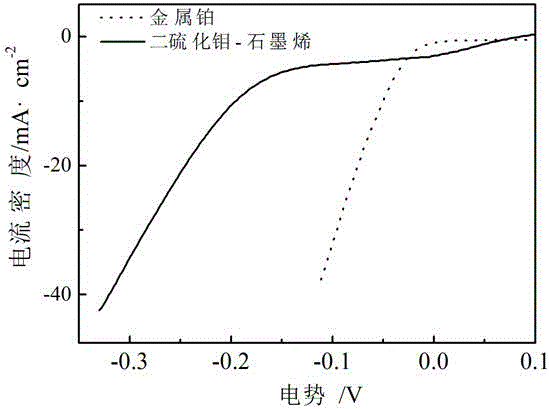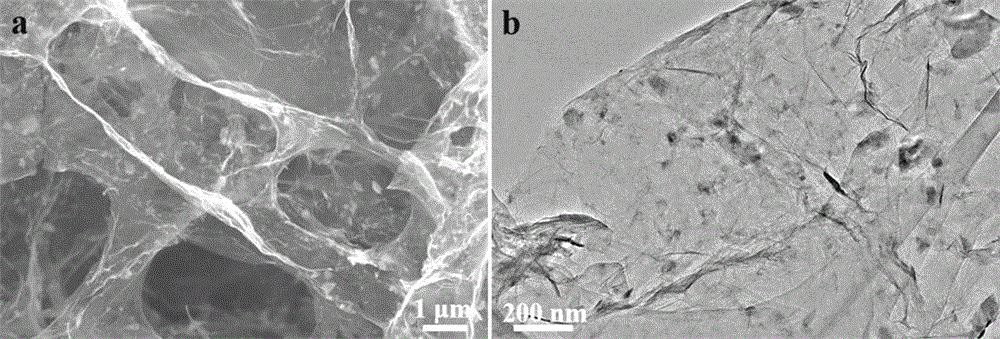Hydrogen evolution reaction catalyst nanosheet layer-graphene three-dimensional composite material and preparation method thereof
A hydrogen evolution reaction and nanosheet technology, which is applied in chemical instruments and methods, physical/chemical process catalysts, nanotechnology, etc., can solve the problems that the morphology, active site and specific surface area of transition metal dichalcogenides cannot be guaranteed. , to achieve the effect of broad industrial application prospect, convenient operation process and low production cost
- Summary
- Abstract
- Description
- Claims
- Application Information
AI Technical Summary
Problems solved by technology
Method used
Image
Examples
Embodiment 1
[0020] Take 0.1 g of molybdenum disulfide powder and place it in 100 mL of N-methylpyrrolidone, and ultrasonically disperse for 6 hours to form dispersion A. Then 0.8 g of graphene oxide was placed in 100 mL of water and ultrasonically dispersed for 24 hours to obtain dispersion B. Take 10 mL of dispersion B and put it in a hydrothermal kettle, then add 20 mL of dispersion A respectively, then sonicate for 3 hours, and then heat the mixture to 200 o C for 12 hours. After the reaction was completed, the hydrothermal kettle was cooled, and the product was taken out, and dialyzed in water for 7 days to remove the solvent and other water-soluble impurities. Finally, the columnar product was frozen in liquid nitrogen, and then freeze-dried with a freeze dryer for 5 days to obtain an airgel.
[0021] From figure 1 It can be seen that the prepared molybdenum disulfide nanosheet-graphene composite has a very obvious pore structure, indicating that its specific surface area is larg...
Embodiment 2
[0023] Take 0.3 g of molybdenum disulfide powder and place it in 50 mL of N,N-diformamide, and ultrasonically disperse for 24 hours to form dispersion A. Then 0.08 g of graphene oxide was placed in 10 mL of water and ultrasonically dispersed for 3 hours to obtain dispersion B. Take 10 mL of dispersion B and put it in a hydrothermal kettle, then add 1 mL of dispersion A respectively, then sonicate for 0.5 hours, and then heat the mixture to 140 o C for 18 hours. After the reaction was completed, the hydrothermal kettle was cooled, and the product was taken out, and dialyzed in water for 5 days to remove the solvent and other water-soluble impurities. Finally, the columnar product was frozen in liquid nitrogen, and then freeze-dried with a freeze dryer for 3 days to obtain an airgel.
Embodiment 3
[0025] Take 0.1 g of tungsten disulfide powder and place it in 30 mL of formamide, and ultrasonically disperse for 18 hours to form dispersion A. Then 0.5 g of graphene oxide was placed in 50 mL of water and ultrasonically dispersed for 12 hours to obtain dispersion B. Take 10 mL of dispersion B and put it in a hydrothermal kettle, then add 1 mL of dispersion A respectively, then sonicate for 0.5 hours, and then heat the mixture to 140 o C for 24 hours. After the reaction was completed, the hydrothermal kettle was cooled, and the product was taken out, and dialyzed in water for 5 days to remove the solvent and other water-soluble impurities. Finally, the columnar product was frozen in liquid nitrogen, and then freeze-dried with a freeze dryer for 3 days to obtain an airgel.
PUM
| Property | Measurement | Unit |
|---|---|---|
| size | aaaaa | aaaaa |
| thickness | aaaaa | aaaaa |
Abstract
Description
Claims
Application Information
 Login to View More
Login to View More - R&D
- Intellectual Property
- Life Sciences
- Materials
- Tech Scout
- Unparalleled Data Quality
- Higher Quality Content
- 60% Fewer Hallucinations
Browse by: Latest US Patents, China's latest patents, Technical Efficacy Thesaurus, Application Domain, Technology Topic, Popular Technical Reports.
© 2025 PatSnap. All rights reserved.Legal|Privacy policy|Modern Slavery Act Transparency Statement|Sitemap|About US| Contact US: help@patsnap.com



